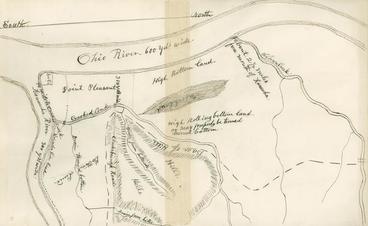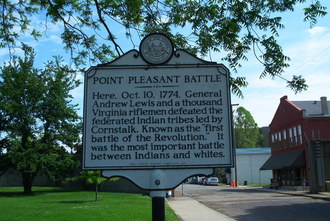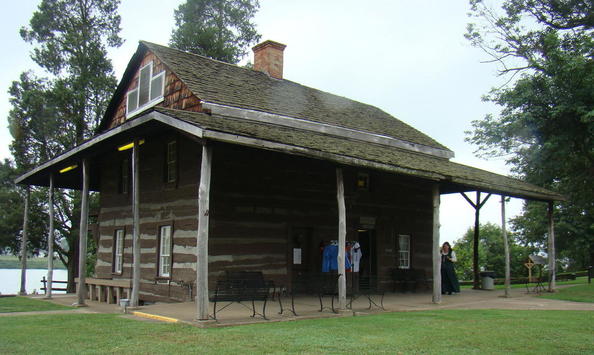|
The first battle of the Revolutionary War is generally considered to be the Battle of Lexington and Concord on April 19, 1775. This is disputed and efforts were made to have the record corrected to have The Battle of Point Pleasant have that distinction. The Battle of Point Pleasant was at first recognized by the National Society of Daughters of the American Revolution as being the first battle fought and female descendants of battle veterans are allowed to join the D.A.R. but was overturned later. The veterans of this battle are not recognized as being soldiers in the American Revolution and did not receive pensions for their actions in this battle. The historical debate about the first battle claim may not yet be resolved for good.  The Battle of Point Pleasant was fought on October 10, 1774 between the settler militia of Virginia and the forces of Shawnee Chief Cornstalk . Point Pleasant is located where the Kanawha River and the Ohio River meet which is now Point Pleasant, West Virginia. The militia victory by the settlers weakened the alliance between native forces and the British and freed up settlers from western Virginia to cross the Allegheny Mountains and join in the American Revolutionary War. In 1774, the Virginia Governor John Murray, the Earl of Dunmore, (who was the last of the royal governors of Virginia) tried to bring peace to the Ohio Valley between the Native Americans and the settlers. Dunmore's plan was to march into the Ohio Valley and force the Indians to accept the Ohio River boundary which had been negotiated with the Iroquois in the 1768 Treaty of Fort Stanwix. However, the Shawnee had not been consulted about the treaty and did not want to give up their lands south of the Ohio River. The Shawnee had been isolated from other Indians by the British Indian Department and had few allies other than a few Mingos Lord Dunmore created two armies and led seventeen hundred men from the north, and Andrew Lewis led eight hundred men from the Kanawha Valley of Virginia. Of Andrew Lewis’ troops, there was listed a William Bryant, private, being a member of the Bedford County [VA] Riflemen. Captain Thomas Buford was the company commander. The roster of the Bedford County Riflemen is the only preserved roster left. I am still researching my Bryant line of the family, but at this point in time I believe a William Bryant was either my 5th or 6th g-grandfather. My Bryant line lived in Bedford County, VA at this point in time and I have only found one William Bryant in the records, still searching. Chief Cornstalk had about 300-500 warriors and moved to intercept Andrew Lewis’ troops, which consisted of the Bedford County Riflemen, where the Ohio River joins the Kanawha to prevent them from joining forces with Lord Dunmore’s troops. The battle lasted for hours and became hand-to-hand. Chief Cornstalk urged his warriors to “be strong.” Captain Lewis sent several companies along the Kanawha and up a nearby creek to attack the Indians from the rear. The Shawnee quietly went back across the Ohio at nightfall while the Virginians held their ground. The militia lost about 75 and had 140 wounded. The losses of the Shawnee could not be totally determined because they threw some of the dead into the river and took the wounded with them. They did find 21 dead braves in the open and 12 more hastily covered with brush and old logs. Pucksinwah, the father of Tecumseh, was among those killed. The following is an excerpt from Wikipedia regarding the battle: “Besides scalps, the Virginians reportedly captured 40 guns, many tomahawks and some plunder which was later sold at auction for 74£ 4s 6d. The Battle of Point Pleasant forced Cornstalk to make peace in the Treaty of Camp Charlotte, ceding to Virginia the Shawnee claims to all lands south of the Ohio River (today's states of Kentucky and West Virginia). The Shawnee were also obligated in the Treaty of Camp Charlotte to return all white captives and stop attacking barges of immigrants traveling on the Ohio River. In April 1775, before many of the Virginians had even returned home from Dunmore's War, the Battles of Lexington and Concord took place in Massachusetts. The American Revolution had begun and Lord Dunmore led the British war effort in Virginia. By the end of that year, the same militiamen who had fought at Point Pleasant managed to drive Lord Dunmore and the British troops supporting him out of Virginia. Before his expulsion, Dunmore had sought to gain the Indians as British allies, the same Indians the militia had defeated at Point Pleasant. Many Virginians suspected he had collaborated with the Shawnees from the beginning. They claimed Dunmore had intentionally isolated the militia under Andrew Lewis, meaning for the Shawnees to destroy them before the Royal Army troops arrived. Dunmore hoped to eliminate the militia in case a rebellion did break out. However, there is no evidence to support this theory and it is generally discounted.  On February 21, 1908, the United States Senate passed Bill Number 160 to erect a monument commemorating the Battle of Point Pleasant. It cites Point Pleasant as a "battle of the Revolution". The bill failed in the House of Representatives. Nevertheless, the Battle of Point Pleasant is honored as the first engagement of the American Revolution during "Battle Days", an annual festival in modern Point Pleasant, now a city in West Virginia.”  The battleground is now known as Tu-Endie-Wei State Park and is located in Point Pleasant, West Virginia. The name an Wyandot Indian phrase meaning "the point between two waters" in English. The park includes the 1796 Mansion House, a historic museum originally used as a tavern. The Colonel Charles Lewis Chapter, N.S. Daughters of the American Revolution operates the Mansion House Museum on a seasonal basis.
2 Comments
Revely B Carwile, Jr.
6/10/2024 01:20:28 pm
Vicky, I am researching Bedford County men at the Battle of Point Pleasant, incl in Capt. Buford's company and other who marched with Botetourt companies (incl. Dudley Callaway, William Teass, and likely others).
Reply
6/10/2024 02:21:15 pm
Mr. Carville: Thank you so much for sharing all this information with me! I did not know of the link to the Boone family. My research on the Bryant family is located at
Reply
Leave a Reply. |
AuthorMy name is Vicky, and after researching my family history since 1999, I have found amazing stories that need to be told. I hope you enjoy them as much as I have! Archives
May 2023
Categories |


 RSS Feed
RSS Feed